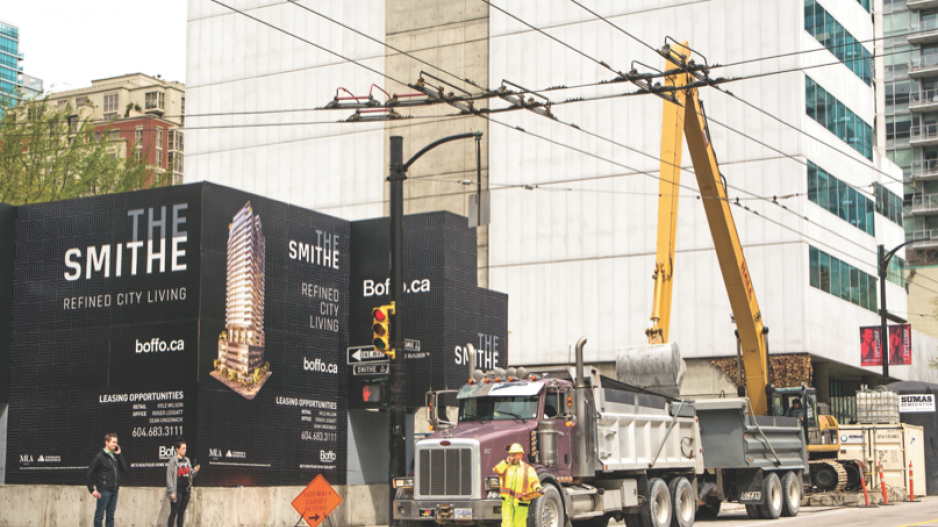At Cambie and Smithe, where Vancouver’s downtown core merges into Yaletown, Boffo Developments is constructing the Smithe. The mixed-use development encompasses more than 31,000 square feet of office space over three levels, two ground-floor retail spaces and 93 two- and three-bedroom homes.
This combination of retail, office and residential is an antidote to the mid-20th-century model of urbanism, where a commercial core would empty out at 5 p.m. and remain largely vacant on weekends. By combining residential life with retail streetscapes and weekday office workers, buildings and neighbourhoods generate round-the-clock activity that invigorates street life. But the combination of tenants and people coming and going at all hours creates particular issues for property managers trying to balance various needs, including security for everyone on the premises.
Karen West, director of marketing and sales for Boffo Developments, says the mixed-use development is good for the neighbourhood.
“Overall, it makes a bit more of a vibrant building,” she says, noting that street-level services may be places residents and office workers use every day, like restaurants or shops, or only occasionally, like insurance firms or travel agencies. “Integrating residential within the business community does create a greater vibrancy.”
Keeping the property and everyone in it safe and happy is part of the design concept, says West.
“That’s actually something we spend an unreasonable period of time thinking about,” she says. Separate entrances for different areas of the building, segregated parkades and even a designated bike entrance are incorporated into the Smithe. “Everything is on a fob-controlled system, where office users will only have access to the office or common areas. Everything is tracked, so if somebody did go somewhere they weren’t supposed to, you’d be able to tell.”
Mixed uses also require specific skills in property managers – and that is a problem in itself, says Warren Smithies, senior vice-president of Martello Property Services. Smithies manages 500,000 square feet of properties, including residential mixed with retail and offices, and says the complexity of managing such facilities has led to a skills shortage in the industry.
“There are not enough new people coming into property management with the skill set necessary to handle these large buildings, which are worth hundreds of millions of dollars potentially,” says Smithies. “It is putting the owners of the strata at risk for mismanagement of their asset over the life cycle of the building.”
While mixed-use projects are beneficial to the cityscape, he says, the difficulties they present for managers include balancing the competing needs of tenants and owners. He cites an example of a West End building that has three separate entities governing it – a ground-floor commercial section with its own strata council, a strata residential section made up of apartment owners and submarket rental housing units operated by a government agency.
“In that one building, you have three entirely separate legal titles with three entirely separate governing bodies that all have to work together in a tight space,” says Smithies. “That can be a big challenge for a lot of people.”
Retailers will want foot traffic in front of their businesses and don’t want to pay for services to the residential component of the building. Residents will be more concerned about noise at night and easy access to and from their homes.
“The different priorities can lead to head-butting on certain issues,” he says. “Parking can be particularly challenging. Even if there is any sort of maintenance issue, like if there’s a leak happening from the residential section into the commercial section, it can be a huge nightmare dealing with that kind of situation where you’ve got multiple insurance companies coming into play, multiple restoration companies. It can get very, very challenging.” He thinks legislation has not been able to keep up with that complexity.
Managing these types of structures is not always an appealing career, Smithies says. The work is typically quite adversarial and includes lots of evening work to accommodate strata council meetings, and councils are looking for the lowest price possible, which leads to cutthroat price competition by management companies and relatively low wages for strata managers.
One of the city’s most visible mixed-use structures underwent an especially challenging renovation recently. Lillian Tummonds is the general manager of what may be Vancouver’s largest single umbrella of mixed-use properties. The 18-year employee of Cadillac Fairview is general manager of Pacific Centre, which includes Pacific Centre mall, seven connected office towers and the Four Seasons Hotel – three city blocks in all.
The redevelopment of the former Sears portion of the mall, which began life as Eaton’s, turned an expansive single-use space into the new Nordstrom and four floors of office space, including two floors occupied by Microsoft, a floor of Sony Pictures Imageworks and a multi-tenant floor on top.
“It was difficult,” she says, laughing. Cadillac Fairview carved out a glass atrium from floors four through seven to give more light to the office space, created a new lobby entrance for the office tower and installed new elevators.
“It was challenging,” she says.
The resulting benefits, though, far outweigh the problems, Tummonds maintains.
“It feels like a community,” she says. “It’s three city blocks of a community and you have all your amenities, like public transit right underneath our complex. You have retail offerings, food offerings – it gives the benefit of a community feeling. It’s beneficial for all the occupants and shoppers. It’s kind of synergistic to have everything tied together.”




